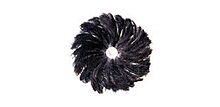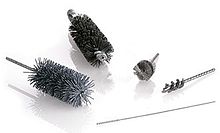Technical brush
Technical brushes are brushes that are developed and manufactured for use in industry and trade . There is a large number of different brush types for the different areas of application.
Brush types
Roller brushes with metal band frame
Roller brushes with a metal band frame can be used in a variety of ways in almost every branch of industry. The construction principle is a spiral-shaped strip brush that is attached to a shaft. With this design, a very high and almost complete filling of the brush fibers is possible. Examples are:
- In the rolling mill industry for supporting descaling, avoiding pickling residues, degreasing and avoiding the silver bronze effect, removing rolling wear and impurities on the strip surface.
- In the metalworking industry for derusting, deburring, roughening and oiling large surfaces made of steel or non-ferrous metal in a continuous process. For removing blasting media or plastic coatings. For the surface finish of strips and sheets made of aluminum and non-ferrous metals.
- In the printing industry for cleaning offset foils and plates, moistening paper webs or washing rubber blankets in offset printing machines.
- In the food industry for cleaning and peeling hard fruits, drum cleaning in vegetable processing, for sorting and washing fruits and vegetables.
- In various industrial areas such as the building materials industry, the ceramics industry, the textile industry, plastics processing, the wood processing industry, for conveyor systems of all branches of industry
Punched round and roller brushes
Punched round and roller brushes are used in many production areas and industrial products because of their versatility and economy. A specific advantage of these brushes is their low weight. The brush body is drilled according to a certain pattern depending on the density of the fillings. The trimmings are then mechanically anchored in the holes. They are suitable for brushing work that does not depend on a particularly high number of revolutions or heavy mechanical loads. They are used for:
- Application and distribution of solid or liquid substances in wood and sheet metal processing
- as cleaning elements in numerous areas
- for pressing on foils and labels
- for powdering baked goods, transporting fruits, seeds etc.
Lath brushes or strip brushes
The slim brushes have a wide range of uses in many branches of industry. Plastic materials in the most varied of qualities are mainly used as the base body. In addition, the classic wooden and metal bodies are still in use:
- For wiping off before cleaning
- As a noise-dampening and gentle brush for CNC cutting and punching machines
- For erecting cardboard blanks
Belt brushes
The characteristic of the belt brushes is the flexibility of the belt body. The brush surface adapts to the vast majority of contours. That is why it is also used in cases where there is not enough space for a brush with a rigid body and correspondingly flexible trimming material. The belt brush can be used horizontally, vertically or in an inclined position. Belt brushes are also ideally used as a cross brush system, i.e. H. for brushing to one side transversely to the direction of travel of belts or the like. Belt brushes are manufactured as V-belts, flat belts and toothed belts.
- For the gentle transport of sensitive workpieces
- For removing deposits on parts or belts in a continuous process, across the direction of travel
Plate brushes
They are used as rotating tools in industry. With a standard diameter of 70 to 300 mm and a very flexible trim arrangement, their area of application is broad:
- For washing, cleaning and polishing surfaces
- For cleaning, waxing and polishing floors
- For deburring, grinding and structuring
Antistatic and ostrich feather brushes
Electrostatic charging of non-conductive substances is a serious disruptive factor: quality losses occur in production, with highly flammable substances there is a risk of fire or explosions, electronic systems are disturbed because electrostatic charges attract dust. When dust is removed, the surfaces are recharged through frictional electricity , so special materials are used here. An electrically conductive material is needed as a trim that does not scratch the surface, but is sufficiently flexible and stiff enough for secure surface contact. Metal wire fails because it attacks the surfaces, so carbon fibers and metal-coated plastic fibers are used. Some antistatic brushes work on the principle of the feather duster . In larger dimensions, ostrich feather brushes , for example in paint lines in the automotive industry, ensure freedom from dust:
- Dust removal and static discharge on vehicle bodies
- Machines that process synthetic fibers into textiles
Conversely, electrifying machines can be equipped with non-metallic brushes in order to separate electrical charge by means of static electricity or as a metallic, electrically conductive sliding contact.
Strip and sealing brushes
Nowadays, brushes are not only used to remove dirt and dust, but also to protect against them. The construction principle is a U-shaped bent sheet metal strip into which a retaining wire with the trim is inserted. The strip brush is produced endlessly and cut to length according to the purpose. The brush is inserted into grooves or metal profiles for attachment:
- Sealing of passages, doors and gates of all kinds against dust, drafts, water, light, heat, noise
- Transporting, guiding and braking sensitive objects
- Protective device, e.g. B. escalators
- On the wheel arches of buses to prevent mud splashes
Tool brushes
Brush, cup and conical disc brushes
The brush, cup and conical disc brushes are used on angle grinders, drills and in machining centers to remove paint, scale and corrosion. They are suitable for work areas that are difficult to access and were specially developed for processing edges and corners.
Inner, boiling tube and alpha honing brushes
Internal brushes are particularly suitable for deburring O-ring grooves and holes for cleaning, smoothing and derusting. They are used on drilling machines, flexible shafts and machining centers.
Boiler pipe brushes are used specifically for cleaning the inside of pipes when derusting, cleaning and descaling. Use for manual machining with flexible shafts but also stationary.
Aphahon brushes are elastic, flexible tools with spheres of abrasive in a synthetic resin bond at their bristle tips. They are used in the areas of cylinder and piston running surface machining.
Round, single disc and pipeline brushes
Round brushes are used for derusting, cleaning, deburring or processing welding seams and removing scale and paint. Individual disc brushes are used to precisely process narrow workpieces or profiled surfaces. They are narrow, aggressive and robust. The possibility of stringing together several individual disc brushes makes them very versatile. Pipeline brushes have proven themselves in the construction of oil, gas and water lines for processing weld seams. They were specially developed for the root and fillet weld. Small round brushes of suitable diameter are used to clean the outside of copper pipes in preparation for soldering, for example for water installation.
Hand
brushes Hand brushes with wooden bodies are produced in different working widths (number of rows). Strip hand brushes have a narrower working surface for fine work, especially in recesses on profiled surfaces. Hand brushes help with cleaning, rust removal, paint stripping and plastering. File brushes are specially designed to clean wooden and metal files. They have a wooden body and a file brush tape is glued to the work surface. Typical are the individually standing wire bristles, bent by about 30 ° in one direction, which are used against their grain and parallel to the grooves of the impact of files or rasps. Wallpaper brushes are very narrow, approx. 35 cm long brushes, which, similar to a squeegee , are used to press pasted wallpaper or poster paper onto a wall or the like without any air bubbles.
literature
- Klaus Przyklenk: Determining the brush behavior using a single bristle. Springer, Berlin et al. 1985, ISBN 3-540-15956-8 ( IPA-IAO research and practice 87), (at the same time: Stuttgart, Univ., Diss. 1985).
- Rainer Maier: Brushing in Practice. In: Alfred P. Thilow: Entgrat-Technik. Development status and problem solutions. 2nd revised edition. Expert, Renningen 2005, ISBN 3-8169-2413-1 ( Contact & Study 392).









